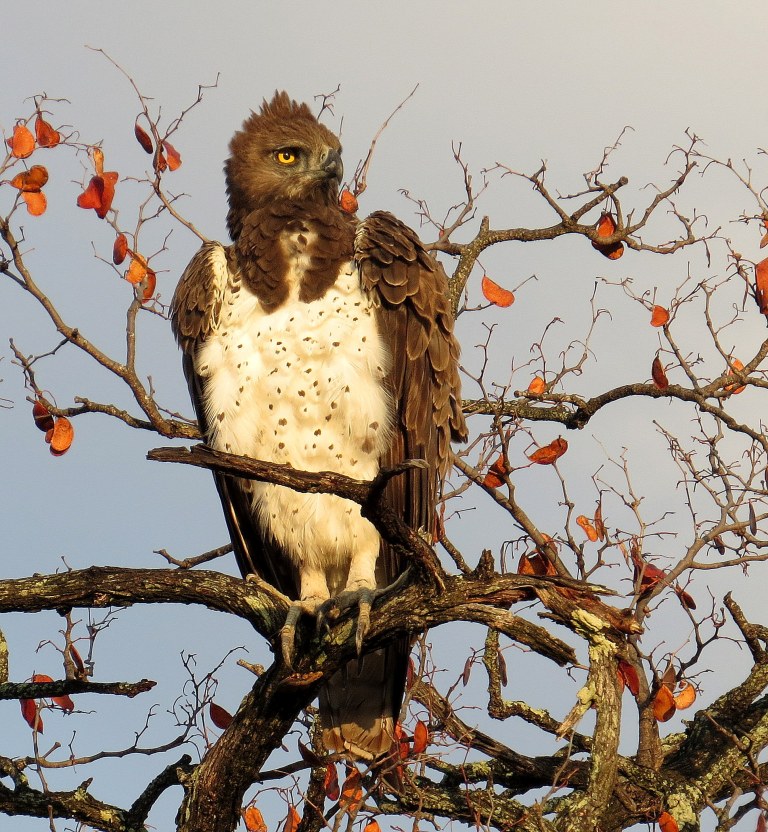We have a new contributor today, William Terre Blanche, with some photos I find particularly interesting, for they’re from where I’m headed in August. William’s notes and captions are indented, and you can enlarge the photos by clicking on them.
As promised, please find attached photos taken in the Kruger Park during my many visits over the years
The Kruger National Park is one of the premier nature reserves of the world, and at 2 000 000 hectares (almost 5 000 000 acres) also one of the largest. The park lies in the far eastern side of South Africa, on the border with Mozambique. On the western side the park is bordered by a number of private reserves, many of them sharing unfenced boundaries with the Kruger Park.
JAC: Here’s a map from Wikpedia showing Kruger in dark red. I’ll be there for several weeks in August!

Let’s start with the famous Big 5. The first 2 (Buffalo and Elephant) are almost guaranteed sightings in the Kruger Park, and with a bit of luck the other 3 as well. (The leopard, being almost exclusively nocturnal, is probably the toughest!)
I am keen birder, and have also included pictures of just some of the many bird species which make the Kruger Park a bird-watchers paradise.
All the below pictures were taken by myself, and all of them in the Kruger Park itself.
Cape Buffalo (Syncerus caffer).
Usually seen in large herds, although older males who are no longer able to keep up with the herd sometimes form small groups of 2 or 3 animals. They are grazers, and therefore mostly seen in grasslands. One of the favourite prey species of lions:

African Bush Elephant (Loxodonta africana).
By far the largest land animal on earth, a big male can weigh more than 6000kg and stand 4m high at the shoulder. They live in small family groups, which may come together to form larger herds. Family groups consist of females and young ones, always led by the matriarch:

Leopard (Panthera pardus)
One of the most sought after sightings in the Kruger Park, and getting a LIT (Leopard in a tree) is always extra special. Active at night, they often rest in a tree during the day. They are mostly solitary, except when mating or when a young cub is with its mother:
Lion (Panthera leo)
The most sociable member of the cat family, often seen in prides, which are always led by a big male, or sometimes a coalition of males (which are usually brothers):
White Rhino (Ceratotherium simun)
Larger and much more common than the Black Rhino. They are grazers and therefore mostly seen where enough grass is available (Black Rhinos are browsers, with a pointed upper lip adapted for this). Both black and white rhinos are actually grey, and can best be distinguished by the difference in size (white rhinos are much larger), and their method of feeding:
Hippopotamus (Hippopotamus amphibus)
Most often seen in rivers and dams, with just the head and ears sticking up above the water. They are selective grazers, and sometimes travel long distances outside of the water to feed, mostly at night:
European Bee-eater (Merops apiaster)
As the name suggests, they are migrants, seen in South Africa from October to April, during the Southern Hemisphere summer. In winter they return to Europe and North Africa, where they also breed:
Little Bee-eater (Merops pusillus)
The smallest bee-eater in the region, they are resident, but with some nomadic movements in response to changing conditions. Usually seen in pairs or small family groups:
African Green Pigeon (Treron calvus)
Often seen near rivers where they feed on the fruit of wild fig trees. They below picture was taken from the restaurant deck at Skukuza Restcamp, which overlooks the Sabi River:
Lilac-breasted Roller (Coracias caudatus)
Probably the most photographed bird in the Kruger Park, for obvious reasons! These brightly coloured birds are common in the Park, and can often be seen perched on small trees next to the road:
Martial Eagle (Polemaetus bellicosus)
One of the largest eagles in the region, with a wingspan of up to 2.4m (the female is considerable bigger than the male). The below picture was taken in the beautiful late afternoon light near Letaba Restcamp:
African Scops Owl (Otus senegalensis)
A small owl (about 15cm), their repetitive insect-like “kruupp” call is a familiar nocturnal sound in the Kruger Park restcamps, where they are often heard, but seldom seen:
Woodland Kingfisher (Halycon senegalensis}
The loud trilling call of the Woodland Kingfisher is probably the one sound that most South Africans associate with hot summer days in the Kruger Park. Despite the name their diet consists largely of insects, and they are mostly seen away from water:












words cannot … breathtaking? Exhilarating? Magnificent?
I am anticipating this trip with great … anticipation…
🙂
Really beautiful photos! Thanks!
Wonderful pictures, thank you and what a place to be privileged to visit.
Thank you for these wonderful photos! It looks like an incredible place.
These are all stunning, but the Scops Owl makes me the most envious! Thank you for these.
All the pictures are fantastic, but I was really taken by the amazing Martial Eagle. What a regal eagle!
Trying to recall any other lilac-colored birds and coming up empty. That kingfisher is pretty cool, too.
That is one fantastic set! Very impressive!
Great pix with useful legends for each. Thanks!
These were a real treat. You captured some truly beautiful animals. Thanks!
Beautiful photos! I remember Africa well.
I’m very curious about the green pigeon. Never knew such a variation existed and wondering how they’re received in South Africa. If the pigeons in Tucson turned green maybe people would quit despising them so. I love the Martial Eagle. Perfectly named. Such beautiful birds in South Africa!